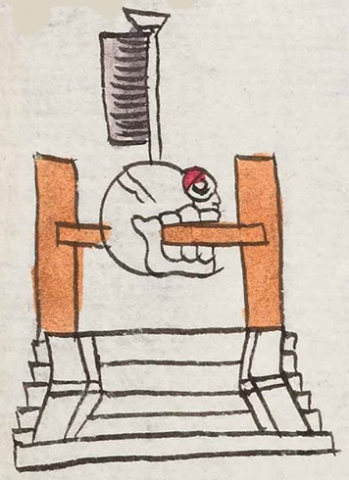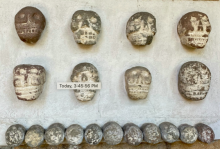Tzompanhuacan (Mdz35r)
This compound sign for the place name Tzompanhuacan has multiple elements. There is an architectural base, upon which stands a wooden, orange-colored skull rack (tzompantli) with one skull on the rack, perforated through the mouth and to the back of the skull with a horizontal plank. The skull is outlined in black and largely without coloring, except for the red eyelid. The eye is open, with the pupil visible. Coming out of the top of the skull (tzontli) is a flagpole with one gray-purple flag flying toward the left. The flag seems to serve as a reiteration of the "pa" element in the place name, deriving from (panitl). The -hua- element of possession does not seem to be represented visually, unless the platform silently holds or possesses the skull rack. Given that this is a place name, perhaps the possession is that of the town's, suggesting the town has a notable skull rack.
Stephanie Wood
The gloss leaves out the first "n" in Tzompanhuacan, but, given that the root is tzompantli, skull rack, it is listed here with that omitted "n" restored.
Stephanie Wood
çonpahuacā, puo
Tzompahuacan, pueblo
Stephanie Wood
c. 1541, or by 1553 at the latest
Stephanie Wood
Tzonpahuacan, Tzunpahuacan, skulls, cráneos, racks, estantes, nombres de lugares
This is a recreation of a tzompantli in carved stone, found in the Museo de Escultura Mexica. The skulls are meant to represent sacrifices made at the temples. Photo by Stephanie Wood, 13 August 2023.

tzompan(tli), skull rack, https://nahuatl.wired-humanities.org/content/tzompantli
pan(itl) or pam(itl), flag or banner, https://nahuatl.wired-humanities.org/content/panitl
-hua (possessor?), https://nahuatl.wired-humanities.org/content/hua
-can (locative suffix), https://nahuatl.wired-humanities.org/content/can-2
"Place Where People Have a Skull Rack" [Frances Karttunen, unpublished manuscript, used here with her permission.]
"Place That Has a Skull Rack" (Berdan and Anawalt, 1992, vol. 1, p. )
"Lugar Donce la Gente Tiene un Estante con Cráneos"
Stephanie Wood
Codex Mendoza, folio 35 recto, https://digital.bodleian.ox.ac.uk/objects/2fea788e-2aa2-4f08-b6d9-648c00..., image 80 of 188.
The Bodleian Libraries, University of Oxford, hold the original manuscript, the MS. Arch. Selden. A. 1. This image is published here under the UK Creative Commons, “Attribution-NonCommercial-ShareAlike 3.0 License” (CC-BY-NC-SA 3.0).







